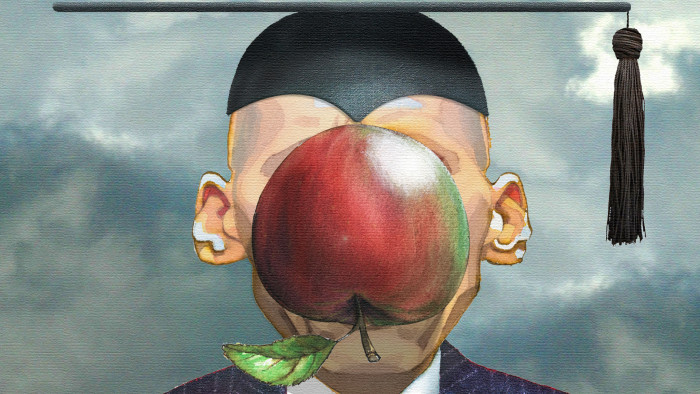Industry savvy teaching keeps courses in the game

Roula Khalaf, Editor of the FT, selects her favourite stories in this weekly newsletter.
If you want to experience the future, they say, move to Silicon Valley.
That is what Sam Grausz did when he crossed the US, from a policy job working on the renewable energy industry in Washington, to study for an MBA at Stanford Graduate School of Business. Within days, he was studying alongside students at Peking University thanks to Stanford’s highly immersive lecture hall, in which a vast video conferencing screen replaces the blackboard. And by the end of that week, his team was presenting a start-up plan to the dual located class.
The 28-year-old admits that a supposedly tech-savvy millennial like himself was nonetheless impressed by the quality of the teaching kit Stanford had installed, although he adds that innovation in such a location is to be expected.
“We are talking about doing business in Silicon Valley here, so it would feel a bit strange if we were not using the most sophisticated technology,” he says.
Yet it is not just Stanford that is experimenting with new methods of teaching. The University of New South Wales Business School, for example, is a long way from Silicon Valley but it has been experimenting with so-called “flipped classrooms”, where students must read and watch course materials before coming to class to discuss them.
The main benefit is increasing the desire to learn, according to Nick Wailes, a professor and associate dean of digital and innovation at UNSWBS, who notes that attendance at the flipped courses is a third higher than others.
“When we ask people why they attend they say it is because they actually feel they learn something,” Prof Wailes says, adding that flipped classrooms are also better suited to teaching soft skills, such as the ability to co-operate on projects in small teams, which is what employers want.
“It is not our job to keep people up to speed on the latest accounting standards,” he says. “The critical thing [for us] is to learn how to learn.”
For 31-year-old Ashley Merrill, who became a mother and a founder while on the Fully Employed MBA, Flex, at UCLA’s Anderson School of Management, using the flipped classroom technique worked because it fitted in with the feeding and sleeping routines caused by the demands of her infant children and her fledgling business.
“I loved that I could rewind through the concepts I was less familiar with, pause, and speed up any areas I was already well versed in,” she says. Many of her fellow students were fortysomethings who equally wanted to study while holding down senior executive roles in banks or law firms.
Change is also being driven by a shift in courses being chosen by students. A decline in the number of people taking electives in traditional subject areas, such as accountancy and finance, has been matched by an increase in those trying to acquire softer skills, such as the ability to write a business plan or pitch for seed funding.
Today’s most popular courses, particularly those around entrepreneurship, are often better learnt by doing, commonly referred to as experiential learning, rather than the case study discussions popularised a century ago by Harvard Business School. This has led to business schools forming teaching partnerships with industry, where students benefit from applying their knowledge to real challenges and the companies gain fresh insights from bright minds.
At Pepperdine University Graziadio School of Business and Management, for example, MBA students work with senior executives over the course of a semester to tackle actual business problems. This “live case” method of teaching has provided practical help to real companies as well as giving students a taste of experiential learning.
“In the past we have had developed lots of ways to create practical learning,” Doreen Shanahan, the programme’s leader, says. “But when you are in the real world with a deadline to get something done, you have real pressure.”
One of the industry executives who got involved in this programme was Bob Mosbaugh, managing director of LH Licensed Products (LHLP). He had signed an agreement with Honeywell for use of its brand in the security products industry and was keen to leverage this position in markets outside the US.
A couple of student teams from Pepperdine were set to work on assessing market opportunities in the UK, France and Russia and LHLP ended up using elements of both proposals since they were so impressed by all the work done. “We got better ideas because we had two competing teams,” Mr Mosbaugh says, himself a Pepperdine MBA graduate. He puts the value of what was a teaching exercise for students at north of $100,000 for his business.
“I thought I was giving back to the school [by getting involved in this programme],” he says. “But I have made back much more than I am giving.”
A key challenge for business schools in this new world of experimentation is not to get carried away as there is still a demand for both new and conventional teaching methods.
Kelsey Doorey is a 2013 Anderson MBA graduate, who, like several of her twenty-something classmates, went on to become an entrepreneur. Although technology is key to her online designer bridesmaid dress hire company, Vow to Be Chic, she claims she chose to study at Anderson because she preferred spending more time learning on campus than in a virtual environment.
“We millennials are split,” she says. “I know I would fail if I had relied on watching lectures online. If I put on a video I would start doing the cleaning and not concentrate on what was being said.”
Other features in this series:
Poor finances threaten business schools
Short tenures signal leadership void
Comments